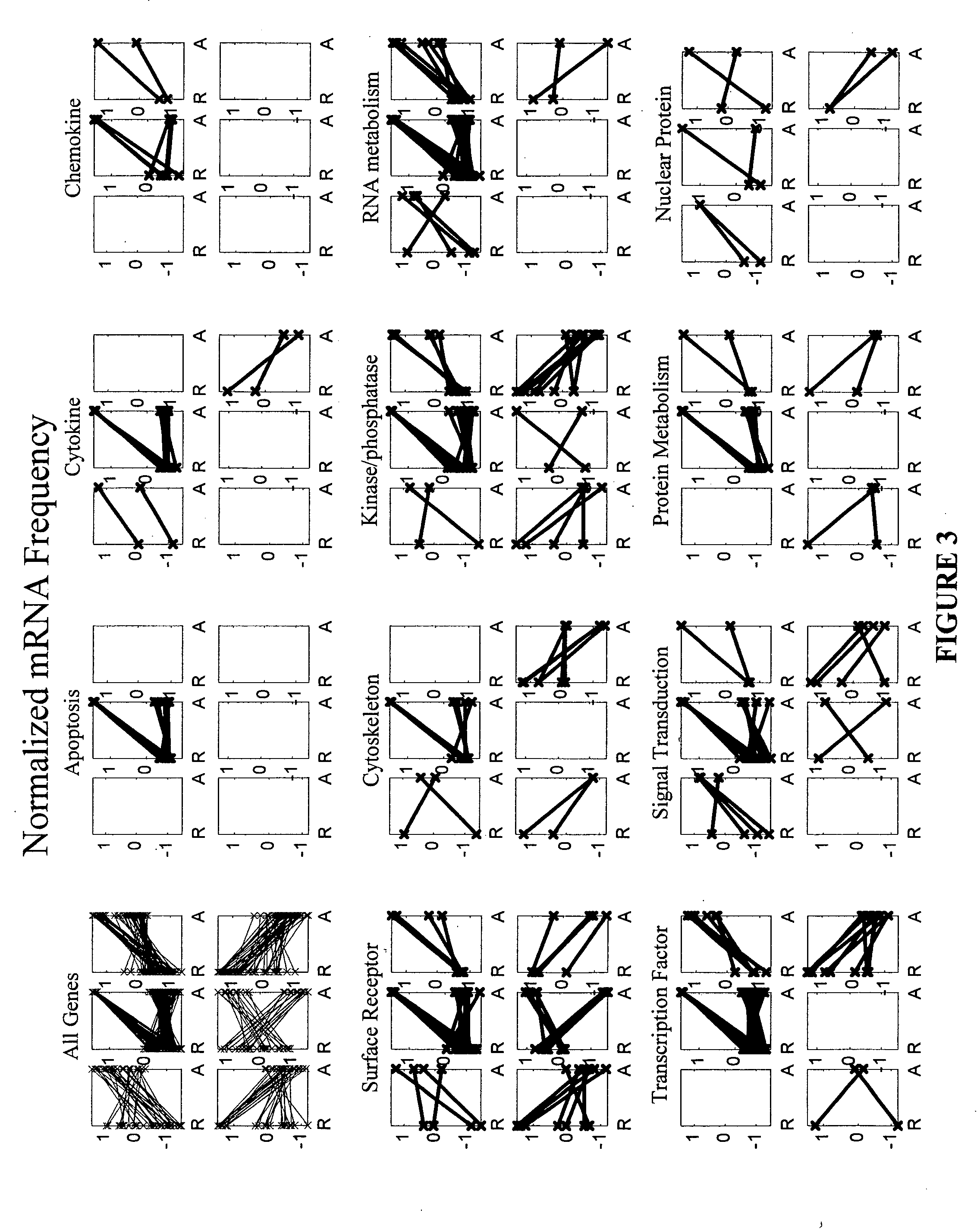Compositions, kits and methods for identification and modulation of type I diabetes
a type i diabetes and kit technology, applied in the field of kit and method for identification and modulation of type i diabetes, can solve the problems of insufficient needs of the subject, ineffective use by the subject, and the exact gene(s) of the putative susceptibility loci responsible for this immune regulation that have proved far more difficult to identify, so as to achieve the effect of improving the level
- Summary
- Abstract
- Description
- Claims
- Application Information
AI Technical Summary
Benefits of technology
Problems solved by technology
Method used
Image
Examples
example 1
Inhibitor Studies
[0244] A known difference between NKT cells in diabetic versus nondiabetic subjects is that while both cells are known to secrete IFN-γ upon activation, the diabetic NKT cells do not secrete IL-4 upon activation, whereas the nondiabetic NKT cells do. To identify which of the known signaling cascades initiated by T antigen receptor ligation played a dominant role in IL-4 secretion, a series of inhibitor studies was performed. The study set forth in this example is incorporated herein, in it's entirety, by reference (Wilson et al. (2000) PNAS 97: 7411-7416).
[0245] Single, Vα24-positive, CD4 / 8 negative single-cell sorts were grown on irradiated allogeneic feeders at 50,000 cells per well with 5,000 cells per well irradiated (5,000 rads) 721.221 lymphoblastoid cells with 1 μg / ml PHA-P, IL-2 and IL-7 each at 10 units / ml (Boehringer Mannheim) and propagated as described (Wilson et al. (1998) Nature 391: 177-181). Clones positive for Vα24 and NKR-P1A by flow cytometry an...
example 2
Identification and Characterization of Marker cDNA
[0247] Peripheral blood leukocytes were stained with fluorescently-conjugated monoclonal antibodies. Stained cells were analyzed on FACScan cytometer (Beckton Dickinson) and single-cell sorting and calcium flux determinations were performed by using a MoFlo cytometer (Cytomation, Fort Collins, N.J.) as described. (Wilson et al. (1998) Nature 391: 177-181).
B. Cell Culture
[0248] Single, Vα24-positive, CD4 / 8 negative single-cell sorts were grown on irradiated allogeneic feeders at 50,000 cells per well with 5,000 cells per well irradiated (5,000 rads) 721.221 lymphoblastoid cells with 1 μg / ml PHA-P, IL-2 and IL-7 each at 10 units / ml (Boehringer Mannheim) and propagated as described (Wilson et al. (1998) Nature 391: 177-181).
C. Messenger RNA Expression
[0249] Vα24JαQ T cell clones GW4 and ME 10 (1×107 cells) were activated for 4 h with 10 μg / ml soluble anti-CD3 or control IgG. The 4 h time point was selected due ...
example 3
Gene Expression in NKT, CD4, and CD8 T Cell Clones
A. Approach
[0254] NKT, CD4, and CD8 T cell clones were generated from a single donor using the methods described above. A single clone of each type was selected and stimulated with anti-CD3 for 2, 4, 8, 24 or 48 hours to create a kinetic activation series. Three replicate experiments were performed for CD4 and CD8, but only one replicate was performed for NKT. The query for the NKT replicate imposed a three-fold change filter. No change filter was imposed for CD4 and CD8; rather, the filter imposed was that genes had to increase or decrease relative to 0 hour for all three replicates. RNA was isolated and analyzed on chips which monitored 12,000 known human genes. The expression data was queried for genes with consistent expression patterns among the three repetitions, and with three-fold changes between the different T cell subsets.
B. Results
[0255] Genes which were identified in a query requiring at least a three-fold increase...
PUM
| Property | Measurement | Unit |
|---|---|---|
| Level | aaaaa | aaaaa |
Abstract
Description
Claims
Application Information
 Login to View More
Login to View More - R&D
- Intellectual Property
- Life Sciences
- Materials
- Tech Scout
- Unparalleled Data Quality
- Higher Quality Content
- 60% Fewer Hallucinations
Browse by: Latest US Patents, China's latest patents, Technical Efficacy Thesaurus, Application Domain, Technology Topic, Popular Technical Reports.
© 2025 PatSnap. All rights reserved.Legal|Privacy policy|Modern Slavery Act Transparency Statement|Sitemap|About US| Contact US: help@patsnap.com



